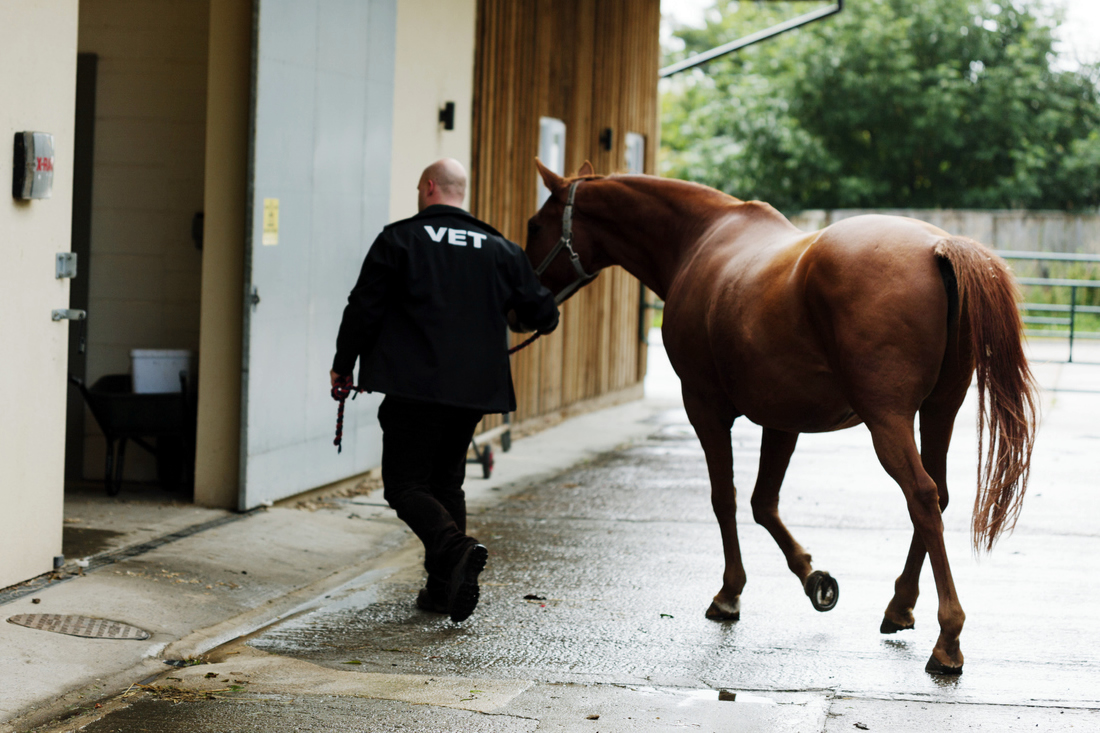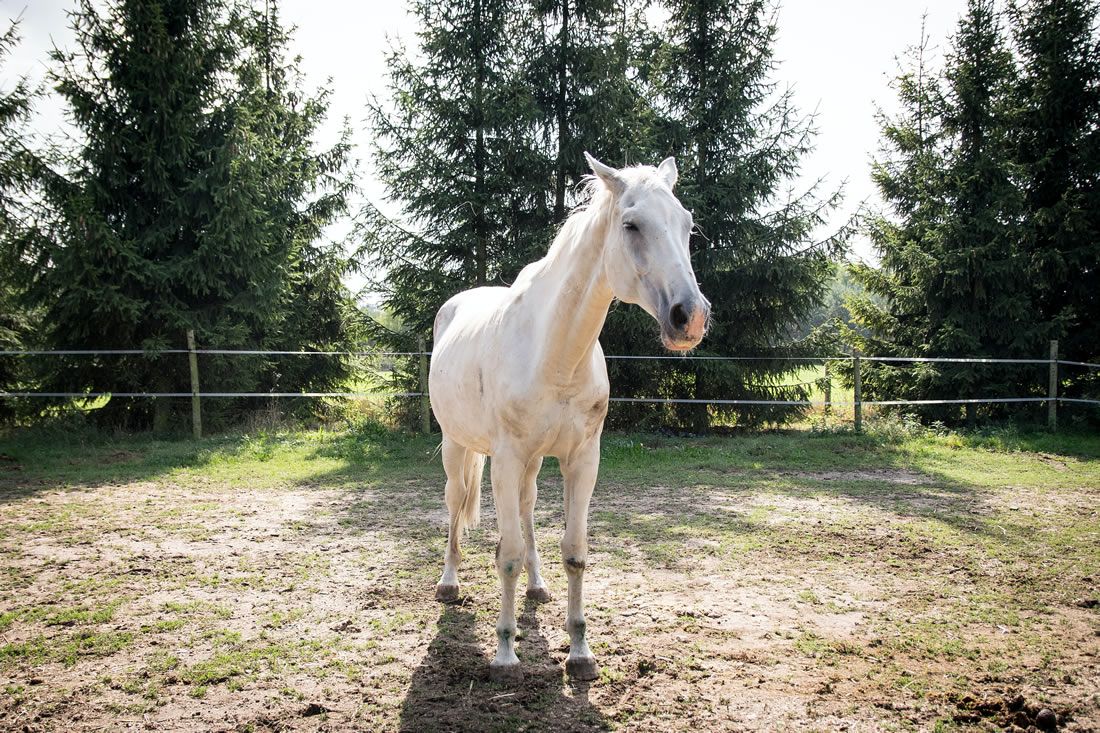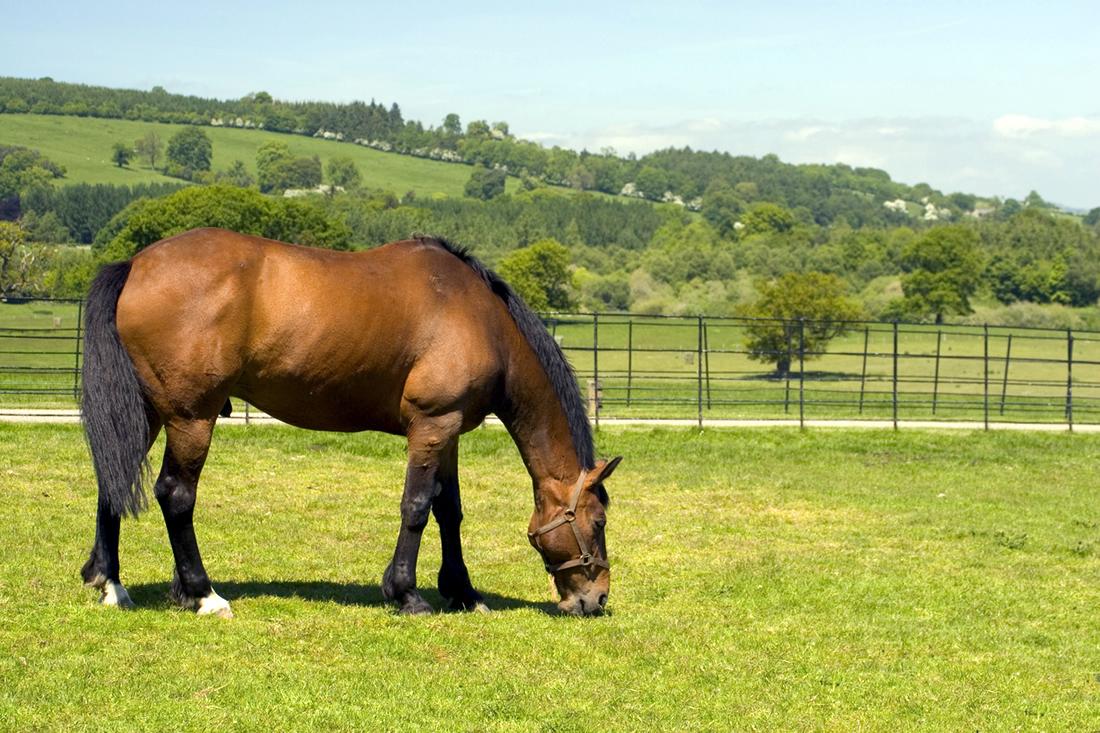Equine herpesvirus (EHV), or rhinopneumonitis, is a contagious infection that is endemic to horses worldwide.
EHV may cause mild to severe symptoms that usually involve the upper respiratory tract. In rare cases, it may cause neurological symptoms, abortion or death. [1]
Horses can experience latent infections of EHV where the virus lives dormant without causing symptoms. [1]
There are nine known types of herpes viruses in horses, of which EHV-1 and EHV-4 are the most common. [2] EHV-1 usually results in more severe symptoms but EHV-4 is more common.
It is estimated that almost every horse is infected with EHV-4 at some point in their life. and many may harbour the latent virus for the rest of their lives. [2][3]
Outbreaks of EHV threaten horse health and welfare and can have significant economic influence. EHV outbreaks can be costly because they can result in the cancellation of events and the isolation and treatment of infected horses. [1]
What is Equine Herpesvirus (EHV)?
EHV is a family of highly contagious DNA viruses that can cause various respiratory and neurological symptoms in horses.
EHV can spread quickly because horses may be contagious even if they are asymptomatic.
After infection, EHV may remain dormant in the horse for the rest of its life. However, the latent virus can be reactivated and result in clinical signs and viral shedding. [3]
Reactivation of EHV may be triggered by stressors such as trailering, castration, weaning, or giving birth. EHV can also be reactivated by the administration of corticosteroids. [2][3][4]
Each subsequent reactivation of latent EHV-1 or EHV-4 is usually less severe than the initial infection. [2][5]
Humans are not at risk of contracting EHV. However, humans may be responsible for spreading it between horses through contaminated hands or clothing.
Symptoms of EHV
The clinical signs of EHV usually appear 2 days after infection and typically last for 8 days. Common symptoms include: [2][4][9]
- Watery nasal discharge which may contain mucus and pus
- Fever
- Swollen lymph nodes
- Appetite loss
- Eye discharge
- Depression
- Coughing
Additional symptoms may occur depending on which form of EHV the horse is infected with. Symptoms are often more severe in younger horses.

Equine Herpesvirus-1 (EHV-1)
The prevalence of EHV-1 is estimated between 13 – 88% in different populations of horses. [1][2][3][4]
Horses can become infected with EHV-1 by nose-to-nose contact with a contagious horse or by coming into contact with respiratory secretions and contaminated equipment, including tack, feed and water buckets, clothing or grooming supplies.
Most adult horses have some immunity to EHV-1 due to previous infection. However, the antibodies are short-lived and may not protect against forms of EHV-1 that can cause abortion or neurological concerns. [8]
EHV-1 is difficult to treat as EHV-1 infected cells can avoid detection from the immune system. [4]
Pathogenesis of EHV-1
EHV-1 can infect different parts of the body and cause different symptoms, which depend on the strain of the virus contracted by the horse. [5]
The virus passes into the upper airways of the horse’s respiratory system which includes the nose, pharynx (throat), and trachea. [4][6]
These airways are lined with a mucosal layer containing epithelial cells. The virus replicates in the epithelial cells causing inflammation, cell damage and respiratory symptoms. [4][6]
EHV-1 can also infect blood vessels. This can result in inflamed blood vessels (vasculitis) and the formation of blood clots that reduce oxygen delivery throughout the body (ischaemic thrombosis). [4][6]
The virus may also reach the peripheral or central nervous system, the lungs, and/or the reproductive organs. [4][7]
In horses with latent EHV-1 infection, the virus infects and remains dormant in cells of the peripheral nervous system and lymphocytes located near the respiratory system. [4]
The latent virus can be reactivated at any time causing the horse to develop clinical signs of EHV-1 and to become contagious.
Respiratory Disease
EHV-1 normally begins in the upper respiratory tract, but it can spread to the lower airways in the lungs and cause bronchopneumonia.
Severe respiratory disease caused by EHV-1 is more common in younger horses, especially weanlings. [8]
EHV-1 respiratory disease is characterized by bleeding, edema, inflamed blood vessels, and low white blood cells in the lungs. [5][9]
Symptoms typically last 9-12 days and can include: [4][8]
- Fever
- Swollen lymph nodes
- Watery nasal discharge
- Coughing
Secondary bacterial infections can occur which cause nasal discharge to contain mucus or pus. [4]
Neurological Disease
If the EHV-1 virus infects the central nervous system, it can result in a neurological disease known as Equine Herpes Myeloencephalopathy (EHM).
The virus can cause bleeding, inflammation, and blood clots that reduce oxygen and nutrient delivery to the brain and spinal cord. [1][4]
Oxygen deprivation and inflammation can cause neurons to degenerate, which results in neurological symptoms. [4]
Symptom onset usually occurs up to 10 days after the horse is infected with EHV-1. [4][7][8][10]
Clinical signs of EHM can include [11]:
- Uncoordinated movements
- Paralysis in one or more limbs
- Fecal and/or urinary incontinence
- Laying down
- Head tilting
- Paralyzed tail
- Blindness
- Build up of fluid in lower limbs
- Weakness
Recovery may take days to weeks depending on how severe the infection is. [5]
The prevalence of neurological EHV-1 varies between outbreaks and the strain of the virus. Some studies report that 10% of EHV-1 infections cause neurological symptoms, while others report neurological symptoms in up to 50% of cases. [1][8][12][20][21]
The following factors affect a horse’s risk of contracting the neurological symptoms associated with EHV-1: [4][5][8][11]
- Age: the risk increases with age
- Breed: Standardbreds, Hispanic breeds, and Draft breeds may be at higher risk, while ponies and smaller breeds may have lower risk
- Sex: Mares (especially pregnant or nursing) are at increased risk
- Season: Most cases occur during winter
- Virus strain
- Presence of fever
Abortion and Neonatal Foal Disease
EHV-1 can reach the uterus in pregnant mares, which may result in abortion of the fetus. [5]
Because EHV-1 is considered a major cause of fetal loss, the virus was previously referred to as Equine Abortion Virus. [4] One study found that 10% of all abortions in a population of thoroughbreds were attributed to EHV-1. [1][5][“22”]
A large majority of abortions caused by EHV-1 occur in the third trimester. [1][5]
EHV-1 arrives at the uterus via the bloodstream. The virus then enters the the inner lining of the uterus and causes inflamed blood vessels and blood clots. [4] The virus causes fetal membranes to detach from the endometrium, resulting in abortion.
EHV-1 can also pass through the umbilical cord to reach and fatally infect the fetus. [4]
A mare infected with EHV-1 close to term may deliver a live foal, but in most cases, the foal does not survive for more than a few days. [4] Foals born alive are often weak, jaundiced, struggle to breathe, and may have interstitial pneumonia. [5]
EHV-1 does not cause lasting infertility or affect future pregnancies, unless a latent infection is subsequently reactivated.
EHV-1 can be easy to miss in mares. However, some mares will show edema in the lower legs, lack of appetite, fever, and respiratory symptoms.
Abortions often coincide with respiratory or neurological EHV-1 symptoms. [4][5]
Effects On Male Fertility
Knowledge of how EHV-1 affects male fertility is limited and requires further research.
One study investigated EHV-1 in pony colts and stallions. Researchers found that the virus was delivered by the bloodstream to the genitalia, specifically the testes and epididymis. [7]
Infected genitalia developed inflamed blood vessels, edema, and blood clots. EHV-1 also caused some of the stallions’ sperm to be malformed, resulting in reducing fertility during the infection. [7]
Eye Infections
EHV-1 can reach the eye causing multifocal lesions on the chorion and retina, also known as chorioretinopathy. Eye infections are usually subclinical but can sometimes result in eye damage, vision impairment and/or blindness. [4]
In experiments, 50-90% of horses infected with EHV-1 contracted lesions in the eye. However, the prevalence of chorioretinopathy may differ outside of experimental settings. [12]
EHV-1 may also cause uveitis or chorioretinitis. These conditions result in painful and inflamed eyes, and may affect the horse’s vision. [8]
Equine Herpesvirus-4 (EHV-4)
EHV-4 infections are often mild and may not cause the horse to experience any symptoms at all.
If symptoms do occur, they mainly consist of respiratory symptoms. EHV-4 is rarely associated with abortions or neurological symptoms.
However, there are several strains of EHV-4 and the severity of symptoms depends on which form the horse is infected with. [2][13]
Like EHV-1, EHV-4 infection begins in the horse’s upper respiratory system. The virus multiplies in the respiratory epithelium and spreads to the lymph nodes and blood. [5]
EHV-4 infects and establishes latency in lymphocytes and cells of the nervous system. [2]
Clinical Signs of EHV-4
Clinical signs of EHV-4 typically last up to 7 days and may include: [5]
- Fever
- Appetite loss
- Nasal discharge
- Swollen lymph nodes
Severe cases of EHV-4 are more common in horses under 2 years and in horses that experience a secondary bacterial infection. [5]
EHV-4 may also cause blood vessel lesions in foals. [2]
Transmission and Prevention of EHV
Horses can contract EHV-1 or EHV-4 from breathing in particles containing the virus or from coming into contact with: [4]
- Secretions (nasal discharge or saliva) from infected horses
- Infected fetal or placental tissues or fetal fluid
- Other infected horses
- Contaminated objects such as equipment, bedding, or clothing
Horses with a latent EHV infection can transmit the virus if it is activated. Latent infections are easily reactivated in mares from the stress of parturition or lactation, which puts foals at high risk of contracting EHV from their mothers. [14]
Horses typically remain viral for 10-14 days after infection, although this depends on the strain of EHV and their immune health. Horses with EHM are usually infectious for longer. [1][4]
EHV-1 can also be transmitted in the semen of colts or stallions up to day 17 – 25 after infection. [7]
Maintaining good biosecurity protocols is important to prevent EHV from spreading between your horses. Biosecurity measures that can reduce the risk of EHV infection include: [5]
- Quarantining new horses for 3 weeks before allowing them to interact with other horses on the farm
- Dividing horses into smaller herds. If EHV breaks out in one herd, the others may not be affected
- Avoiding putting pregnant mares in stressful situations, especially during the third trimester
- Keeping records of when and where horses have travelled
Risk Factors for EHV
Any horse can become infected with EHV, but horses with a higher risk of contracting EHV include: [16]
- Horses in the racing industry
- Horses under 3 years old
- Horses in a herd with an infected horse
- Horses experiencing stress (ie: weaning, trailering, and those pre-existing health conditions)
Horses are also more likely to contract EHV-1 in the late fall, winter, and spring. In contrast, EHV-4 is consistently present throughout the year.
One study investigating an EHV-4 outbreak in Germany found that stressful experiences, such as exercise and changes in management practices, contributed to the outbreak. However, the researchers could not conclude whether the stress caused the true infections or if it reactivated the latent virus. [19]
Horses under 2 years old usually have more severe clinical symptoms and are at greater risk of contracting respiratory EHV-1. [1][4]
Foals are commonly infected with EHV-4 around the time of weaning. They may become infected through contact with their mothers or by interacting with contagious foals. [5]
Evidence suggests that foals can receive EHV antibodies from the mare through colostrum if the mare was previously infected. However, these antibodies wear off and can leave foals susceptible to the virus around the time of weaning. [18]
Diagnosis & Treatment of EHV
Contact your veterinarian if your horse has a confirmed or suspected exposure to EHV or if they are shows symptoms related to EHV.
EHV can be diagnosed with a nasopharyngeal swab or blood sample using virus isolation or a PCR test. Real-time PCR testing is considered the best choice for diagnosing EHV. [1]
Blood samples will only test positive if the virus has entered the horse’s bloodstream. [1]
Infected horses should immediately be quarantined. All equipment, surfaces and items that may have come into contact with the infected horse should be disinfected.
Horses that have come into contact with infected horses should also be monitored for fever or other signs of EHV.
Medications
There is no standard drug to treat EHV-1 or EHV-4. However, there are measures that can help infected horses recover. [4]
EHV symptoms can be treated with supportive therapy such as antipyretics or anti-inflammatories including phenylbutazone, flunixin meglumine, or dimethyl sulfoxide. [10] IV fluid therapy may also be provided.
Corticosteroids can be provided, but their usefulness is controversial. Corticosteroids treat inflammation but suppress the immune system, which could hinder the horse’s recovery. [5]
Anti-viral medications, such as acyclovir and valacyclovir, may also be administered. [5]
Valacyclovir can reduce fever, neurological symptoms, and viral shedding. Valacyclovir is most effective when administered before the horse becomes infected, but is also effective if given during the first 2 days of infection. [17]
Acyclovir is another antiviral drug similar to valacyclovir. However, it is poorly absorbed and less effective than valacyclovir. [5]
Contact your veterinarian to determine the best treatment plan if your horse is infected with EHV.
Vaccines
Vaccines have been developed for EHV. However, they are not fully effective because EHV can avoid detection by the immune system. [4][15]
Vaccination may reduce symptoms and decrease viral shedding, but do not prevent EHV-1. Vaccines are also more effective against some forms of EHV than others. [3]
While vaccines have limited efficacy, they can still benefit horses by reducing the severity of the infection and improving recovery prognosis. Vaccines can also make horses less contagious by reducing viral shedding. [16]
Treating Pregnant Mares with EHV-1
There is no way to prevent EHV-1-induced abortion in affected mares or to treat neonatal foal disease.
If the mare experiences abortion, fetal and placental tissues should be removed and her tail and hindquarters should be thoroughly cleaned to prevent spreading the virus. [5]
Treating Neurological EHV-1
There is no cure for neurological EHV-1. However, care and management strategies can help to keep infected horses comfortable.
Contacting your veterinarian immediately when an outbreak occurs or during the first 2 days of infection can reduce the severity of EHM.
Horses that are paralyzed, recumbent or have mobility issues may require special access to food and water. [5]
The horse may also require a bladder catheter to empty their bladder and may also need assistance emptying their rectum. [5] Flushing the bladder and providing antibiotics may help reduce or prevent bladder inflammation. [5]
Recumbent horses are at risk of bedsores and aspiration pneumonia, which may occur if breathing in feed or water while trying to eat. Your veterinarian may recommend antibiotics to treat or prevent bedsores and pneumonia. [5]
Providing your horse with thick, cushioned straw or bedding and turning the horse over every 4-6 hours can also help prevent bedsores from forming. [5]
Prognosis for EHV
Most horses infected with EHV are asymptomatic or have very mild symptoms. The prognosis for these horses is excellent, and most fully recover within one to two weeks.
However, more severe clinical cases can occur. In these cases, EHV can be fatal or cause lasting effects on the horse.
The following factors are correlated with a higher likelihood of surviving EHV-1: [10]
- Treatment with anti-viral drugs
- Younger age (between 1 – 5 years)
- Peak temperature of 103.5oF (39.7oC) or less
- Peak temperature on or before the second day of fever
- No severe neurological symptoms
Neurological EHV-1 Prognosis
It is estimated that 50 – 91% of horses survive the neurological form of EHV-1. However, this depends on the severity of their symptoms. [8][10]
Horses that have not become recumbent and can stand up on their own usually recover. Recovery can take anywhere from days to months. [4]
Horses that have become recumbent because of paralysis or that have developed other complications such as incontinence often do not fully recover.
In these cases, horses may not survive, and those that do are usually humanely euthanized. [4]
Respiratory EHV-1 Prognosis
Most horses recover from EHV-1 effects on the respiratory system. However, severe cases can result in respiratory distress and be fatal. [5]
Reproductive EHV-1 Prognosis
Mares that abort or deliver weak foals usually make a full recovery. The virus is eliminated from the reproductive tract and future pregnancies are not affected unless the virus establishes latency in the mare. [4]
If the mare sustains a latent infection, it is important to minimize her stress during future pregnancies to avoid activating the virus and causing an abortion.
Choriotretinal EHV-1 Prognosis
Chorioretinal lesions are usually permanent and may leave the horse with limited vision. [12]
EHV Outbreak Protocols
In the event of an EHV outbreak in your area or on your farm, consider these protocols: [5][10]
- Immediately quarantine horses that you suspect may have EHV or that have tested positive for EHV.
- If you suspect that your horse has been exposed and/or contracted EHV, contact your veterinarian immediately to obtain a diagnosis. Your veterinarian will recommend treatment and a plan to prevent further EHV spread.
- Monitor susceptible horses for signs of infection and take temperatures regularly.
- Keep broodmares away from the rest of the herd to prevent EHV-induced abortion.
- Care for healthy horses before infected horses to avoid transmitting the virus to healthy horses.
- Use different equipment, tack, buckets and grooming supplies for infected horses and non-infected horses.
- Shower and change clothing and footwear after being in contact with infected horses.
- Disinfect or dispose of items that come into contact with infected horses, including clothing and equipment.
- Limit visitors on the premises.
- If there is an outbreak on your farm, do not allow any horses to leave the premises until 3 weeks after the last infected horse has recovered.
- Stalls used to house infected horses should be thoroughly disinfected, and should remain empty for 3 weeks before being re-used.
References
- Lunn, D.P. et al. Equine herpesvirus-1 consensus statement. J Vet Intern Med. 2009.
- Patel, J.R. et al. Equine herpesviruses 1 (EHV-1) and 4 (EHV-4) – epidemiology, disease and immunoprophylaxis: a brief review. Vet J. 2005.
- Zineb, E.B. et al. Seroprevalence of equine herpesvirus 1 (EHV-1) and equine herpesvirus 4 (EHV-4) in the northern Moroccan horse populations.. Animals (Basel). 2021.
- Laval, K. et al. The pathogenesis and immune evasive mechanisms of equine herpesvirus type 1. Front. Microbiol. 2021.
- van Maanen, C. Equine herpesvirus 1 and 4 infections: an update. Vet Q. 2002.
- Negussie, H. et al. Replication characteristics of equine herpesvirus 1 and equine herpesvirus 3: comparative analysis using ex vivo tissue cultures.. Vet Res. 2016.
- Tearle, J.P. et al. Replication of equid herpesvirus-1 (EHV-1) in the testes and epididymides of ponies and venereal shedding of infectious virus. J Comp Pathol. 1996.
- Paillot, R. et al. Equine herpes virus-1: virus, immunity and vaccines. Open Vet Sci J. 2008.
- Gibson, J.S. et al. Pathogenesis of equine herpesvirus-1 in specific pathogen-free foals: primary and secondary infections and reactivation. Arch Virol. 1992.
- Henninger, R.W. et al. Outbreak of neurologic disease caused by equine herpesvirus?1 at a university equestrian center. J Vet Intern Med. 2007.
- Allen, G.P. Risk factors for development of neurologic disease after experimental exposure to equine herpesvirus-1 in horses. Am J Vet Res. 2008.
- Hussey, G.S. et al. Experimental infection with equine herpesvirus type 1 (EHV-1) induces chorioretinal lesions. Vet Res. 2013.
- Matsumura, T. et al. Epizootiological aspects of type 1 and type 4 equine herpesvirus infections among horse populations. J Vet Med Sci. 1992.
- Gilkerson, J.R. et al. Epidemiology of EHV-1 and EHV-4 in the mare and foal populations on a Hunter Valley stud farm: are mares the source of EHV-1 for unweaned foals. Vet Microbiol. 1999.
- Cruz, F. et al. Seroprevalence and factors associated with equine herpesvirus type 1 and 4 in Spanish Purebred horses in Spain. Vet Rec. 2016.
- Pusterla, N. et al. Prevalence factors associated with equine herpesvirus type 1 infection in equids with upper respiratory tract infection and/or acute onset of neurological signs from 2008 to 2014. Vet Rec. 2016.
- Maxwell, L.K. et al. Efficacy of the early administration of valacyclovir hydrochloride for the treatment of neuropathogenic equine herpesvirus type-1 infection in horses. Am J Vet Res. 2017.
- Gilkerson, J.R. et al. Epidemiological studies of equine herpesvirus 1 (EHV-1) in Thoroughbred foals: a review of studies conducted in the Hunter Valley of New South Wales between 1995 and 1997. Vet Microbiol. 1999.
- Pavulraj, S. et al. Equine herpesvirus type 4 (ehv-4) outbreak in Germany: virological, serological, and molecular investigations. Pathogens. 2021.
- Friday, P.A. et al. Ataxia and paresis with equine herpesvirus type 1 infection in a herd of riding school horses. J Vet Intern Med. 2008.
- Slater, J. Chapter 14 – equine herpesviruses. Equine Infectious Diseases (Second Edition). 2014.
- Mumford, J.A. et al. Serological and virological investigations of an equid herpesvirus 1 (EHV-1) abortion storm on a stud farm in 1985. J Reprod Fertil Suppl. 1987.












Leave A Comment